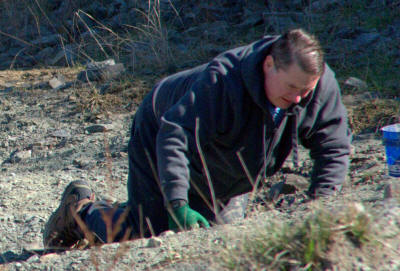

September 2018
|
101 American Fossil Sites You've Gotta
See, |
I have loved fossils for decades, and looked forward to learning more about them and the places they could be experienced. I started this book with high hopes, but was disappointed in it for three reasons: poor site selection, its many errors, and its purple prose.
 On
the plus side, I loved the Preface – don’t skip it. The format is great, with
one page of text per site and a page of photos. A real plus was having GPS
coordinates and some pertinent references for each site. The photos are
generally good, although I wondered why some were included. For example, for
Dinosaur National Monument (site 87) why show a photo of the rocks outside
rather than a picture of the spectacular wall of bones itself?
On
the plus side, I loved the Preface – don’t skip it. The format is great, with
one page of text per site and a page of photos. A real plus was having GPS
coordinates and some pertinent references for each site. The photos are
generally good, although I wondered why some were included. For example, for
Dinosaur National Monument (site 87) why show a photo of the rocks outside
rather than a picture of the spectacular wall of bones itself?
As to the places selected for inclusion, I know that every fossil enthusiast would choose a different group of 101 fossil sites, and I appreciate the author’s attempt to select sites from as many geographic areas of the United States as possible, but this book had some that I really questioned. For example, the State House in Augusta, Maine (site 37) has a few fossils in its floor tiles. I realize Maine doesn’t have much in the way of fossils, but those in its State House aren’t even from that state, they are from Vermont. A number of other state capitol buildings have much better fossils on display.
Also, when the best fossils at a site are nondescript brachiopods and bits of crinoids, all smaller than a penny (such as sites 32 & 45), is it really a fossil site you’ve gotta see? And one site (21, Brevard Museum of History and Natural Science) was about anthropology, not paleontology.
And for the good sites I often wanted more information about that particular location and its fossils rather than the large amount of text given to things only tangentially related, such as Australian opal (page 124), the personalities of fossil hunters (page 100) and the Byzantium and Ottoman Empires (page 88).
There were also many errors, only a few of which will be mentioned here. The Academy of Natural Sciences is not at Yale (p. 40) it is in Philadelphia. That was an odd error, considering one of the sites included (16) is the PeabodyMuseum, which is the one at Yale.
Brachiopods do not have a left valve that is the mirror image of a right valve (as he informs us on page 78) – those are clams. Petrified wood (p. 124) tree molds (p. 159) and steinkerns (p. 178) are not trace fossils. Trace fossils result from activities such as walking (leaving footprints) burrowing (leaving burrows) and biting (leaving tooth marks). They are even defined as such in the book’s own glossary.
Tylosaurus was not a marine mammal (p. 181) but a mosasaur, a marine reptile related to the group of modern lizards that includes the Komodo Dragon.
Tooth enamel is not calcareous as he tells us on page 128, it is phosphatic. And the idea that Gryphaea oysters became extinct because they coiled so much that they couldn’t open their shells (page 178) hasn’t been taken seriously by paleontologists for decades.
Perhaps the most annoying part of this book was his purple prose. One example should suffice. After mentioning creatures like the Devonian fish Dunkleosteus, the dinosaur Tyrannosaurus, and the Pleistocene saber cat Smilodon, he says, “These notorious carnivores stain the pages of geologic history much like Jack the Ripper and Bloody Mary soil the pages of contemporary history.” Ugh. Really?
Mountain Press has produced many fine books in the past. This one could have been much improved had it been given a good look-over by a paleontologist.